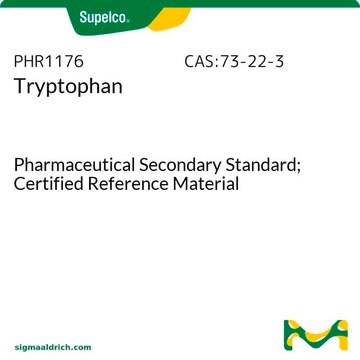Kluczowe dokumenty
162698
DL-Tryptophan
≥99% (HPLC), for peptide synthesis
Synonim(y):
(±)-α-Amino-3-indolepropionic acid, (±)-2-Amino-3-(3-indolyl)propionic acid, DL-3β-Indolylalanine
About This Item
Polecane produkty
Nazwa produktu
DL-Tryptophan, ≥99% (HPLC)
Poziom jakości
Próba
≥99% (HPLC)
Formularz
powder
przydatność reakcji
reaction type: solution phase peptide synthesis
mp
289-290 °C (dec.) (lit.)
Zastosowanie
peptide synthesis
ciąg SMILES
NC(Cc1c[nH]c2ccccc12)C(O)=O
InChI
1S/C11H12N2O2/c12-9(11(14)15)5-7-6-13-10-4-2-1-3-8(7)10/h1-4,6,9,13H,5,12H2,(H,14,15)
Klucz InChI
QIVBCDIJIAJPQS-UHFFFAOYSA-N
Szukasz podobnych produktów? Odwiedź Przewodnik dotyczący porównywania produktów
Powiązane kategorie
Opis ogólny
Zastosowanie
Kod klasy składowania
11 - Combustible Solids
Klasa zagrożenia wodnego (WGK)
WGK 1
Temperatura zapłonu (°F)
Not applicable
Temperatura zapłonu (°C)
Not applicable
Środki ochrony indywidualnej
Eyeshields, Gloves, type N95 (US)
Wybierz jedną z najnowszych wersji:
Certyfikaty analizy (CoA)
Nie widzisz odpowiedniej wersji?
Jeśli potrzebujesz konkretnej wersji, możesz wyszukać konkretny certyfikat według numeru partii lub serii.
Masz już ten produkt?
Dokumenty związane z niedawno zakupionymi produktami zostały zamieszczone w Bibliotece dokumentów.
Klienci oglądali również te produkty
Active Filters
Nasz zespół naukowców ma doświadczenie we wszystkich obszarach badań, w tym w naukach przyrodniczych, materiałoznawstwie, syntezie chemicznej, chromatografii, analityce i wielu innych dziedzinach.
Skontaktuj się z zespołem ds. pomocy technicznej











